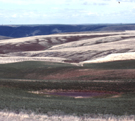Holocene Temperatures and Sea Level Changes
Taylor, George H. Holocene Temperatures and Sea Level Changes. Western Institute for Study of the Environment, December, 2007
George H. Taylor is a Certified Consulting Meteorologist and Director of the Oregon Climate Service, Oregon State University.
Full text [here]
Selected excerpts:
At the end of the last Ice Age, global temperatures increased significantly and ushered in an interglacial period known as the Holocene. According to Pielou (1991), the interglacial is now more than half over, with temperatures having peaked about 10,000 years ago.
On the basis of a variety of “proxy” indicators (parameters which allow estimates of climate change), there is much evidence for the early Holocene peak…
1. Based on studies of latitudinal displacements of terrestrial vegetation (Bernabo and Webb, 1977; Wijmstra, 1978; Davis et al., 1980; Ritchie et al., 1983; Overpeck, 1985) and vertical displacements of alpine plants (Kearney and Luckman, 1983) and mountain glaciers (Hope et al., 1976; Porter and Orombelli, 1985), it has been concluded (Webb et al., 1987; COHMAP, 1988) that mean annual temperatures in the Midwestern United States were about 2 °C warmer 8,000 years ago than temperatures of the past few decades (Bartlein et al., 1984; Webb, 1985).
2. At about the same time, summer temperatures in Europe were 2 °C warmer than present (Huntley and Prentice, 1988), as was the case in New Guinea (Hope et al., 1976), and temperatures in the Alps were as much as 4 °C warmer (Porter and Orombelli, 1985; Huntley and Prentice, 1988).
3. In the Russian Far East, temperatures are also reported to have been from 2 °C (Velitchko and Klimanov, 1990) to as much as 4-6 °C (Korotky et al., 1988) higher than at present; while the mean annual temperature of the Kuroshio Current between 22 and 35 °N was 6 °C warmer (Taira, 1975), and the southern boundary of the Pacific boreal region was positioned 700 to 800 km north of its present location (Lutaenko, 1993)…
This warmer period has customarily been referred to as the Holocene Climatic Optimum (MacCracken et al., 1990; Ciaia et al., 1992; Lutaenko, 1993; Lambin et al., 1996) because the warmer (and in many cases, wetter) conditions are thought to have been beneficial to society and ecosystems. Further, during this period the world experienced “the rise of human civilization, based on the development of agriculture (Whyte, 1995).”…
Viau, et al (2006) constructed “A mean continental July temperature reconstruction based on pollen records from across North America” which “quantifies temperature variations of several timescales for the past 14,000 cal yr BP.” They found that “temperatures increased nearly 4°C during the late glacial, reaching maximum values between 6000 and 3000 cal yr BP, after which mean July temperatures decreased.” During the Holocene, “climate in North America appears to have varied periodically every ?1100 years rather than the ?1500 year cycle found during the last glacial period. Coherence at frequencies between 900 and 1100 years between land, ice, and ocean records suggests a common forcing associated with widespread surface impacts during the Holocene.”…
In the Arctic, according to Kaufman, et al (2004), “Paleoclimate inferences based on a wide variety of proxy indicators provide clear evidence for warmer-than-present conditions at 120 [proxy] sites. At the 16 terrestrial sites where quantitative estimates have been obtained, local HTM temperatures (primarily summer estimates) were on average 1.67 + 0.8°C higher than present (approximate average of the 20th century), but the warming was time-transgressive across the western Arctic. As the precession-driven summer insolation anomaly peaked 12–10 ka (thousands of calendar years ago), warming was concentrated in northwest North America, while cool conditions lingered in the northeast. Alaska and northwest Canada experienced the HTM between ca 11 and 9 ka.” …
Unlike air and sea surface temperatures, which peaked thousands of years ago and have declined since, sea levels have shown steady increases since the last ice age, when they were more than 100 meters lower than today’s.
There is ample evidence that air and sea temperatures were significantly higher than present conditions approximately 10,000 years ago. Some researchers see this as evidence for an inexorable movement toward the next ice age (see, for example, Pielou, 1991). Recent temperature rises are rather insignificant compared to these longer-term variations.
Sea level rise does not show the same type of behavior as the air and sea temperatures. Rather, there has been a continuous rise in sea level since the last glacial maximum ended. However, the rate of rise had dropped steadily over the last several thousand years, and shows signs of continued decline over the last hundred.
